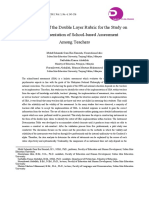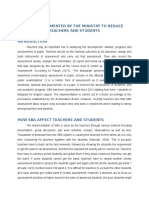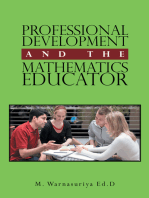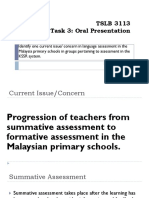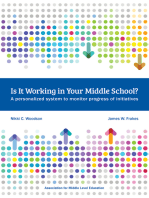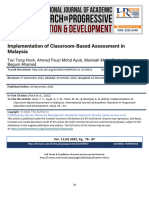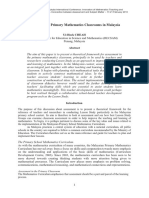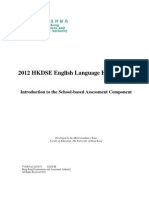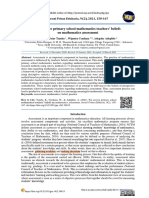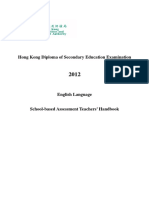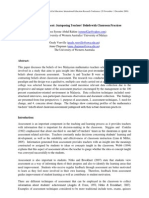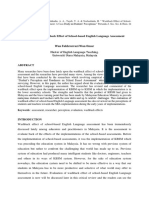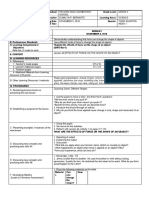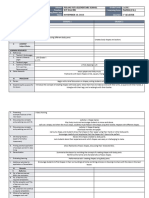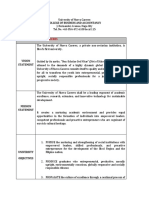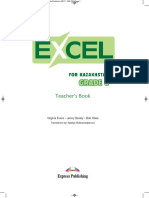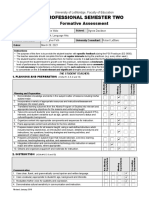SBA Assessment
Uploaded by
Sharan DhaliwalSBA Assessment
Uploaded by
Sharan DhaliwalPertanika J. Soc. Sci. & Hum.
25 (S): 71 - 80 (2017)
SOCIAL SCIENCES & HUMANITIES
Journal homepage: http://www.pertanika.upm.edu.my/
Re-assess or Risk the Slow Death of School Based Assessment
Parmjit Singh*, Kaarthiyainy Supramaniam and Teoh Sian Hoon
Faculty of Education, Universiti Teknologi MARA, 40450 Shah Alam, Selangor, Malaysia
ABSTRACT
The aim of this study is to analyse the success of School Based Assessment (SBA)
implemented in 2010/11 in Malaysia. It examines teachers’ readiness, confidence level and
enjoyment in teaching mathematics. It also investigates if participation in SBA professional
development courses impacted on teachers’ readiness for it. A total, of 260 teachers (65
males and 195 females) were selected as respondents while 12 teachers were interviewed
for their feedback. The findings show= that the teachers involved in the study have a low
level of readiness and confidence in implementing SBA. Professional development courses
related to SBA did not have any impact on teachers’ readiness level. More than two-thirds
of them reported that they did not enjoy teaching since the implementation of SBA. This
study indicates more effort is needed to enhance teachers’ competency in achieving the
goals of SBA.
Keywords: Confidence, implementation, professional development courses, readiness, School Based Assessment
INTRODUCTION easily through public examinations (Hong
School Based Assessment (SBA) assesses Kong Examinations and Assessment
the cognitive, affective and psychomotor Authority, 2013). Under the new assessment
domains. The objective of SBA is to enhance system, good students could progress faster
student learning which cannot be assessed whilst the weaker ones are allowed to
take up more time in learning. The SBA
approach in evaluating students’ academic
progress was officially introduced by
the Ministry of Education Malaysia and
ARTICLE INFO
Article history: was implemented periodically in line
Received: 15 September 2016
Accepted: 30 January 2017
with the Standards-based Primary School
E-mail addresses:
Curriculum beginning 2011 as part of
[email protected] (Parmjit Singh), Malaysia’s educational transformation
[email protected] (Kaarthiyainy Supramaniam),
[email protected] (Teoh Sian Hoon) reform (Malaysian Examination Syndicate,
* Corresponding author
ISSN: 0128-7702 © Universiti Putra Malaysia Press
Parmjit Singh, Kaarthiyainy Supramaniam and Teoh Sian Hoon
2012). The transformation of the current arithmetic skills in early 2000s, but this
system was initiated to move away from practice too ended. In 2004, PPSMI was
centralised examinations and to focus on introduced whereby Mathematics and
continuous assessment, improve student Science were taught in English to improve
learning, conduct more holistic assessments, their English language skills. Despite an
and improve examinations at the school investment of more than RM1 billion on
and central levels. Chappuis and Chappuis teaching and learning tools and professional
(2008) claim that SBA is able to provide development, it was shelved in 2011/12.
relevant information to students during the Subsequently, SBA was introduced in Year
learning stage, enhance their performance 1 in 2011 and Secondary 1 in 2012 mainly
and status of their achievements to meet due to students’ poor performance in TIMSS
their learning objectives. In addition, and PISA studies (2003 to 2011).
formative assessment techniques provided In light of the changes over the last two
information on the quality of teaching (Hall decades, this research attempts to answer
& Burke, 2003). the following research questions: a) are
The SBA confers greater responsibility teachers affected by the implementation
on the teachers to design quality of SBA have understood the philosophy of
assessments that match students’ learning SBA?; b) are teachers confident and ready
outcomes. However, it was discovered that to conduct SBA?; c) Do the teachers have
teachers’ workload had increased since the competency in varying their repertoire
the implementation of SBA, resulting in of teaching strategies to purposes?; and
dissatisfaction with the policy (Azrul, d) are teachers expected to be creative
2011; Lee, 2012). Teachers are required to in using various teaching strategies and
record their assessments online but they repertoire of methods in assessing their
experience frequent server malfunctions. students? Tong and Adamson (2015) opined
Azlin, Ong, Mohamad, Rose, and Nurhayati, that assessments are an important tool in
(2013) confirmed that “under this system, facilitating student progress in learning.
teachers are given greater responsibility Hence, teachers must have high levels
to design quality assessments that align of confidence while assessing student
with the learning outcomes” (p.102). Their performance in SBA. There is also a need to
additional responsibilities include updating know if attending professional development
the filing systems which contain students’ SBA courses has significant relationship
evidence of learning and their examination with teachers’ readiness in conducting SBA.
marks. On the contrary, there have been In a study conducted by Alaba (2012),
various measures put in place to enhance it was revealed that more than half of the
mathematics teaching. For example, abacus teachers in Nigeria were not prepared for
(also known as Sempoa) was introduced the implementation of SBA and which led
to boost pupils’ computation and mental to the scrapping of the policy. Another
72 Pertanika J. Soc. Sci. & Hum. 25 (S): 71 - 80 (2017)
Re-assess or Risk the Slow Death of School Based Assessment
pressing issue is whether or not teachers METHODS
are contented with the teaching process. Structured interviews were conducted with
Various educational reforms have taken 260 respondents who are primary school
place in Malaysia over the last two decades mathematics teachers who taught in Primary
that may have adversely affected teachers. 1, 2 and 3 in Selangor. A total of 68%
Studies have shown that teachers experience (n=195) of the respondents were females
exhaustion and burnout (Azlin, et. al., 2013; while 32% (n=65) were males. This was
Azrul, 2011; Lee, 2012; Friedman, 1996; followed by structured interviews with eight
Merseth, 1992). Maslach, Leiter and Jackson teachers.
(2012) explain that burnout is a general term
to describe different negative consequences RESULTS
of work that include emotional exhaustion,
depersonalisation and lack of personal Research Question 1:
accomplishment. This study was undertaken What is the level of teachers’ readiness in
to examine the challenges faced by teachers implementing SBA?
due to the implementation of SBA. Hence, In measuring teachers’ readiness (Table
the objectives of the study are to: 1)procedure of SBA, marking criteria,
i. Investigate teachers’ readiness and moderation system and assessment
confidence in assessing student philosophy all the mean scores for the
performance via SBA. items (procedure of SBA, marking criteria,
moderation system and assessment
ii. Examine the relationship of
philosophy) ranged from 5.89 (SD=1.69)
attending professional development
to 6.20 (SD=1.74) with an overall mean
courses in SBA with teachers’
score of 6.10 (SD=1.65). Based on the
readiness levels.
overall mean score of 6.10, primary school
iii. Assess teacher’s enjoyment in teachers are not ready to conduct SBA in
teaching mathematics since the their classroom teaching. This low level of
implementation of SBA. readiness is not accepted as a competent
level for teachers. They do not understand
The findings of the study would help in the fundamentals of implementing SBA.
ensuring that SBA is implemented more Thus, students are not being assessed as
effectively in the Malaysian education per the SBA.
system.
Pertanika J. Soc. Sci. & Hum. 25 (S): 71 - 80 (2017) 73
Parmjit Singh, Kaarthiyainy Supramaniam and Teoh Sian Hoon
Table 1
Teacher’s readiness in implementing SBA (n=260)
Mean SD
I have a good understanding of the requirement of SBA 6.20 1.74
I have a good understanding of the procedure of SBA 6.19 1.72
I have a good understanding of the marking criteria of SBA 6.15 1.76
I have a good understanding of the moderation system of SBA 6.04 1.77
I have a good understanding of the underlying assessment philosophy of SBA 5.89 1.69
Overall 6.10 1.65
Scale 1= Least, 10 = Most
Research Question 2 using SBA, an instrument consisting of six
What is the level of teachers’ confidence in items was utilised. Each question followed
analysing students’ performance in SBA? the scale that represented a choice from 1
To analyse teachers’ confidence level and (least) until 10 (most).
ability in assessing the student’s performance
Table 2
Teachers’ confidence levels since the implementation of SBA
Teachers’ confidence Mean SD
I am confident in evaluating students’ mastery using bands provided (from 1 to 6.23 1.56
6 - poor to excellent) or other forms of standard benchmarking.
I can give clear explanations regarding students’ achievements according to 6.28 1.64
their mastery level.
I can access each student individually according to his or her needs 6.14 1.74
I can confidently plan the next teaching and learning activity in meeting the 6.27 1.57
students’ needs based on their feedback
I feel confident in determining students’ ability and position in class according 6.24 1.56
to the criteria based on their performance standards.
I feel confident judging students based on the clear criteria of evaluation 6.19 1.62
according to the performance standards available.
Overall 6.21 1.52
Scale 1= Least, 10 = Most
Table 2 shows the highest mean score meeting the students’ needs based on their
obtained for the item ‘give clear explanations feedback” (M=6.27, SD=1.57). On the
regarding students’ achievement according other hand, the lowest level of confidence
to mastery level’ (M=6.28, SD=1.64) is obtained for the item ‘I can access each
followed by “I can confidently plan the student individually according to his or her
next teaching and learning activity in needs’ (M=6.14, SD=1.74). The other items
74 Pertanika J. Soc. Sci. & Hum. 25 (S): 71 - 80 (2017)
Re-assess or Risk the Slow Death of School Based Assessment
are in the range of 6.19 (SD=1.62) to 6.24 Table 3
Number of related SBA courses attended since the
(SD=1.56). Based on the overall mean score
implementation
of 6.21 (SD=1.52), it can be clearly seen
that teachers do not have the confidence nor Courses attended Frequency Percentage
1-2 157 63.3
the ability to assess students’ performance
3-4 69 27.8
using SBA. Additionally, data indicates the
5-6 9 3.6
teachers are ill prepared in utilising SBA
7-8 3 1.2
philosophy to improve student learning and More Than 8 3 1.2
achievements. Total 241 100
Research Question 3
Is there any significant relationship teachers’ readiness and courses attended, we
between the teachers’ level of readiness divided the course attended between 1 and 2
and attending professional development courses, and 3 and more courses.
courses in SBA?
H0: There is no significant difference
In terms of course attended, Table 3 shows
between the teacher’s readiness in
63.3% (n=157) respondents attended
conducting SBA and the numbers of
between 1 and 2 courses followed by 27.8%
courses attended.
(n=69) respondents who attended between
3 and 4 courses. There were 6.0% (n=15) H1: Teachers attending more courses (3 and
of respondents who had attended 5 or more above) has a higher level of readiness in
courses. conducting SBA.
In analysing the relationship between Table 4 shows that the mean scores for
Table 4
T-test comparing mean score between teachers’ readiness and the number of courses attended
Courses Attended N Mean SDt df p
Readiness 1-2 157 6.04 1.64 -1.622 238 .106
3 and above 84 6.40 1.63
teachers attending 3 or more courses related SBA courses have a higher level of
(mean=6.40, SD=1.63) is higher than readiness than their counterparts attending
those attending 1 to 2 courses (mean=6.04, 1 to 2 courses, these differences are not
SD=1.64). However, the t-test analysis significant. In other words, attending more
indicates no significant difference [t (238) professional development courses did
= -1.622, p=.106] between both these scores not seem to have any effect in enhancing
at the 0.05 level. Thus, we fail to reject teachers’ level of readiness in implementing
the null hypothesis. This clearly indicates SBA.
that although teachers attending 3 or more Research Question 4:
Pertanika J. Soc. Sci. & Hum. 25 (S): 71 - 80 (2017) 75
Parmjit Singh, Kaarthiyainy Supramaniam and Teoh Sian Hoon
What is the percentage of teachers’ lot of work to do.” - (T4, 3, F)
enjoyment in teaching mathematics since
the implementation of SBA? •• “It has become difficult to see their
progress in learning and their interest
Ta b l e 5 s h o w s t e a c h e r s ’ l e v e l o f
in specific skills”- (T6, 3, F)
enjoyment teaching mathematics since the
implementation of SBA. •• “SBA made teachers’ feel burdened
Based on Table 5, 52.9% (n= 137) of and at the same time cheating became
easy and biasness was evident when
awarding marks.”- (T11, 2, M)
Table 5
Do you enjoy teaching since the implementation of •• “It’s difficult to know the level of
SBA? students’ understanding. The SBA
Enjoyment Frequency Percentage requirement can’t dictate the students’
Yes 137 52.9 understanding because teachers will ask
No 122 47.1 the students to complete the task given
Total 259 100 until a correct answer is attained.”-
(T12, 3, F).
respondents said that they enjoyed teaching
since the implementation of SBA compared Analysis of teachers’ feedback about
with 47.1% (n=122) who said no. This implementation of SBA
finding indicates nearly half of the teachers Research question: If given a choice, will
were discontented since the implementation you like to continue or discontinue the
of SBA. The following issues and concerns implementation of SBA in schools?
faced by the teachers were extracted during Table 6 describes the respondent’s view,
the interviews. if given a choice, whether to continue or
(Teacher No (from 1 to 12), Level discontinue with SBA. Data shows 51.9%
(Primary 1, 2 or 3), Gender) (T2, 1, F) (n=135) respondents do not want to continue
indicates Teacher 2, Primary One and compared with 47.5% (n=122) who said yes.
Female The following information was extracted
•• “I have no time to make my class more
attractive” - (T2, 1, F) Table 6
Teachers views to continue with the implementation
•• “Most of my time is spent on filling up of SBA
forms and making online submissions” Frequency Percentage
(T3, 3, F) Yes 122 47.5
•• “My time to teach has deteriorated No 135 51.9
and the additional topic in syllabus Total 257 100
increased the subtopic made me have a
76 Pertanika J. Soc. Sci. & Hum. 25 (S): 71 - 80 (2017)
Re-assess or Risk the Slow Death of School Based Assessment
during the interviews: in conducting SBA in their school since
the implementation of SBA?
•• “Ministry of education must look
back at this new implementation. Try The findings indicate that the teachers
to reduce the workload of teachers or are not ready (Mean=6.10, SD = 1.65) to
conduct SBA in their schools although it
increase the staff to help the teachers,
was implemented since 2011. Similarly,
and if that cannot be done it is best to
abolish it!”- (T5, 2, M) they do not have the confidence (Mean=
6.21 SD=1.52) and ability to assess student’s
•• “Parents could not accept their children
performance using SBA. This suggests
ability without doing the exam…we
that the policy could fail if no measures
faced lots of difficulty…….so much
are taken to address the issues raised by
burden for us… rather berhentikan
the teachers. In the Malaysian context,
(stop it) sahaja seperti (like) PPSMI”
educational policies are often regulated
- (T12, 3, F)
at the national level by the ministry. This
•• “How to determine the level of students’ top down approach has often proven to
comprehension and understanding if be ineffective in synchronising practices
they do not take the exam? Exams are and aspirations of the proposed policy, as
still needed” - (T6, 3, F) confirmed by studies ( LeCzel & Gillies,
•• “It puts both students and teachers 2006). Reflecting on the past failures of
under stress, to achieve the highest using sempua for teaching of math and
band and to carry out the assessment science in English (PPSMI) indicate that
respectively…If given a choice, I’d more needs to be done in order to ensure
decline.” that policies like SBA is successful as the
latter is demanding, and labour intensive.
DISCUSSION AND CONCLUSION It demands greater levels of commitment
as well as cooperation from the already
The introduction of SBA system in stages by
overstretched teachers. Teachers are already
the Ministry of Education Malaysia in 2011
overburdened with administrative duties
to evaluate students’ academic progress was
such as record keeping and participating in
in line with the implementation Standards-
extracurricular activities. The underlying
based Primary School Curriculum. This was
fear is that teachers may experience burnout,
part of Malaysia’s educational reform. This
a phenomenon that has not been thoroughly
study was aimed at examining teachers’
addressed.
views on the effectiveness of the policy
Findings suggest that professional
since its inception.
development courses attended by teachers
What is the level of teachers’ readiness involved in this study have little impact on
Pertanika J. Soc. Sci. & Hum. 25 (S): 71 - 80 (2017) 77
Parmjit Singh, Kaarthiyainy Supramaniam and Teoh Sian Hoon
their readiness to implement SBA. Some mathematics…- (T6, 3, F).
of the challenges are described as follows:
Findings also suggest a need for efficiency
•• The courses I attended were a waste of
in conducting professional development
time. We were forced to attend a half day
courses. First, having a one-off or one-day
workshop where we merely sat down
work shop is ineffective especially if the
and listened to a boring lecture from
policy to be implemented requires a shift
the instructor. - (T4, 3, F)
from current practices; rather, it should be
•• I attended two courses in my district. an on-going one over a prolonged period of
We were asked to accept the policy …… time. This fundamental principal has been
I don’t believe in the SBA and there is supported by researchers (Yoon et al, 2007;
no way we can assess students without Bush, 1984) decades ago. Second, though
exams. - (T12, 3, F) these teachers understand the principles
•• The courses were alright, such that of SBA, they faced problems with its
in the first workshop, the instructor implementation, namely in translating
was good and got us involved in theory into practice.
hands on activities to enhance our The reason traditional professional
understanding…. there were lots of Q development is ineffective is that it does not
and as during the one day workshop…… support teachers during the implementation
However more on-going workshops are phase. In implementing any new policy, it
in need to grasp better knowledge of the is common for even experienced teachers
School based Assessment. - (T5, 2, M) to struggle initially (Ermeling, 2009;
Joyce & Showers, 1982). If this is so, what
•• I understand SBA as explained by the
more could be expected of new teachers?
speaker but implementing it was a
Studies reveal that it takes an average of 20
different story altogether. Self-practice
separate practices for a teacher to master
and discovery is crucial and works
a new skill, which also increases with the
better as opposed to mere adherence to
complexity of the skill (Joyce & Showers,
a set of fixed rules.” - (T7, 3, M)
2002). Bush (1984) and Truesdale (2003)
•• We definitely need more hands-on (as cited in McCrary, 2011) confirmed that
workshops specifically in the field of when a skill is merely described, only 10
mathematics teaching. The instructor percent of participants can translate the
we had ventured more into the English new knowledge to practice; however,
language aspect giving more examples when teachers are coached through the
on it than actually focusing on phase of implementation, 95 percent could
mathematics teaching per se. Most of transfer the target skills. Thus, support
my colleagues faced the same problem and encouragement could be extended
in assessing students’ learning in to an optimum level of 50 to 80 hours
78 Pertanika J. Soc. Sci. & Hum. 25 (S): 71 - 80 (2017)
Re-assess or Risk the Slow Death of School Based Assessment
of instruction, practice, and coaching ACKNOWLEDGEMENT
(Banilower, 2002; Yoon, Duncan, Lee, The authors gratefully acknowledge Ministry
Scarloss, & Shapley, 2007). Hence, teachers of Education, Malaysia for providing the
could be provided the opportunity to Fundamental Research Grant Scheme
master the necessary skills at the initial (Project Number: FRGS/1/2014/SS109/
stages. Clearly, this could also boost their UITM/01/1).
confidence and readiness in class which
this research showed they lacked. In short, REFERENCES
the current implementation of professional Alaba, A. A. (2012). Teacher’s Perception of School-
development courses in enhancing teachers Based Assessment in Nigerian Secondary
practices definitely need to be reassessed. School, Mediterranean Journal of Social
Another issue that must be addressed is Sciences, 3, 99-109.
teacher burnout. Nearly half (47.1%) of the Azlin N. M., Ong, H. L., Mohamad S. R., Rose A.
respondents have shown signs of discontent R., & Nurhayati Y. (2013). The Benefits of
in teaching since the implementation of the School-Based Assessment, Asian Social Science,
SBA and more than half (51.9%) indicated 8, 101-106.
that they disapproved SBA. These are signs Azrul A. S. (2011, September 21). Guru merungut
of gradual burnout (Shaheen, & Mahmood, program SAPS lebih sukar dari manual.
2015; Skaalvik, & Skaalvik, 2011; Gavish Berita Harian Online. Retrieved from http://
perkhidmatanpelajaran.blogspot.my/2011/09/
& Friedman, 2010). Hence, guidance for
guru-merungut-program-saps-lebih-sukar.html
teachers is mandatory to begin with. Creating
awareness of its importance is vital as well Banilower, E. (2002). Results of the 2001-2002
study of the impact of the local systemic change
as to allow them to coordinate their existing
initiative on student achievement in science.
and target practices. Not doing so would
Arlington, VA: National Science Foundation
result in teachers using random techniques
Borg, M. G. (1990). Occupational stress in British
that may not be effective. Hence, policy
educational settings: A review. Educational
makers are urged to assess teachers’ current
Psychology, 10, 103-126.
competency in SBA, ensure meaningful and
Bush, R. N. (1984). Effective staff development in
relevant professional development courses
making schools more effective: Proceedings of
for them to enhance their competency and
three state conferences. San Francisco, CA: Far
create a platform for discussing changes West Laboratory.
related to SBA for knowledge management.
Chappuis, S., & Chappuis J. (2008). The best value in
This study strongly recommends that policy
formative assessment. Educational Leadership,
makers re-examine and address the issues 65(4), 14-19
of SBA or face the risk of its slow demise.
Ermeling, B. (2009). Tracing the effects of teacher
inquiry on classroom practice. Teaching and
Teacher Education, 26(3), 377-388.
Pertanika J. Soc. Sci. & Hum. 25 (S): 71 - 80 (2017) 79
Parmjit Singh, Kaarthiyainy Supramaniam and Teoh Sian Hoon
Friedman, I. A. (1996). Multiple pathways to McCrary, M. (2011). Mapping the Road to
burnout: Cognitive and emotional scenarios in Instructional Coach Effectiveness: Exploring
teacher burnout. Anxiety, Stress and Coping: An the Relationship between Instructional Coaching
International Journal, 9(3), 245-259. Efficacy, Practices, and Outcomes (Doctoral
Dissertation, Georgia State University, US).
Gavish, B., & Friedman, I. A. (2010). Novice teachers’
Retrieved from http://citeseerx.ist.psu.edu/
experience of teaching: a dynamic aspect of
viewdoc/download?doi=10.1.1.425.8041&rep
burnout. Social Psychology of Education, 13(2),
=rep1&type=pdf
141-167.
Merseth, K. K. (1992). First aid for first-year teachers.
Hall, K., & Burke, W. M. (2003). Making Formative
Phi Delta Kappan, 75(9), 678-683.
Assessment Work: Effective Practice in the
Primary Classroom. England, Maidenhead: Malaysian Examination Syndicate (2012). Panduan
Open University Press. Pengurusan SBA. Kementerian Pelajaran
Malaysia. Lembaga Peperiksaan, 2011.
Hong Kong Examinations and Assessment Authority.
Pengurusan dan Pengendalian: Pentaksiran
(2013). Hong Kong diploma of secondary
Berasaskan Sekolah (SBA). Kuala Lumpur:
education examination: Information on school-
Kementerian Pelajaran Malaysia.
based assessment. Retrieved 25 August, 2016
from http://www.hkeaa.edu.hk/DocLibrary/ Shaheen, F., & Mahmood, N. (2015). Exploring
Media/Leaflets/SBA_pamphlet_E_web.pdf. the Level of Emotional Burnout among Public
School Teachers. The Sindh University Journal
Joyce, B., & Showers, B. (2002). Student achievement
of Education, 44(1), 116 – 135
through staff development. Alexandria, VA:
Association for Supervision and Curriculum Skaalvik, E. M., & Skaalvik, S. (2011). Teacher job
Development. satisfaction and motivation to leave the teaching
profession: Relations with school context,
Joyce, B., & Showers, B. (1982). The coaching of
feeling of belonging, and emotional exhaustion.
teaching. Educational Leadership, 40(1), 4- 10.
Teaching and Teacher Education, 27(6), 1029-
Lee, E. (2012, August 8). Why the rush to change. 1038.
The Star Online. Retrieved August 15, 2012
Tong, S. A., & Adamson, B. (2015). Student Voices
from http://thestar.com.my/news/story.
in School-based Assessment. Australian Journal
asp?file=/2012/8/8/focus/11817252&sec=focus
of Teacher Education, 40(2).
LeCzel, K. D., & Gillies, J. (2006). From policy
Truesdale, W. T. (2003). The implementation of
to practice: The teachers’ role in policy
peer coaching on the transferability of staff
Implementation in Namibia. Washington DC:
development to classroom practice in two
USAID.
selected Chicago public elementary schools.
Maslach C., Leiter M., & Jackson S. (2012). Making a Dissertation Abstracts International, 64(11),
significant difference with burnout interventions: 3923.
Researcher and practitioner collaboration.
Yoon, K. S., T. Duncan, S. W. Lee, B. Scarloss, &
Journal of Organizational Behavior, 33, 296-
K. L. Shapley. 2007. Reviewing the Evidence
300.
on How Teacher Professional Development
Affects Student Achievement (Issues and Answers
Report, REL 2007 No. 033). Washington,
DC: U.S. Department of Education, Regional
Educational Laboratory Southwest.
80 Pertanika J. Soc. Sci. & Hum. 25 (S): 71 - 80 (2017)
You might also like
- Pros and Cons of School Based Assessment in Malaysia (SBA)100% (1)Pros and Cons of School Based Assessment in Malaysia (SBA)4 pages
- ARTICLE ISSUE 3 - English Teachers' Voices On The Challenges of The School-Based AssessmentNo ratings yetARTICLE ISSUE 3 - English Teachers' Voices On The Challenges of The School-Based Assessment10 pages
- Name: Hafifah Binti Kusin MATRIC NUMBER: 2020.8.EDU02.002: Article ReviewNo ratings yetName: Hafifah Binti Kusin MATRIC NUMBER: 2020.8.EDU02.002: Article Review8 pages
- 2020 Narrativesof Englishlgteachersontehimpelentationfo SBAin SWakNo ratings yet2020 Narrativesof Englishlgteachersontehimpelentationfo SBAin SWak19 pages
- Validity of Teacher-Made Assessment: A Table of Specification ApproachNo ratings yetValidity of Teacher-Made Assessment: A Table of Specification Approach8 pages
- Assessment Literacy and School Accountability in The Context of Education Reform in Malaysia1No ratings yetAssessment Literacy and School Accountability in The Context of Education Reform in Malaysia110 pages
- Teachers’ Perceptions of Their Literacy Professional DevelopmentFrom EverandTeachers’ Perceptions of Their Literacy Professional DevelopmentNo ratings yet
- Student Teacher's Perceptions of the Pre-Service Mathematics Programme in a Primary Teachers' College in ZimbabweFrom EverandStudent Teacher's Perceptions of the Pre-Service Mathematics Programme in a Primary Teachers' College in Zimbabwe5/5 (1)
- Effects of an Inclusion Professional Development Model on Inclusion Knowledge and Perceptions of Regular Middle School EducatorsFrom EverandEffects of an Inclusion Professional Development Model on Inclusion Knowledge and Perceptions of Regular Middle School EducatorsNo ratings yet
- Is It Working in Your Middle School?: A Personalized System to Monitor Progress of InitiativesFrom EverandIs It Working in Your Middle School?: A Personalized System to Monitor Progress of InitiativesNo ratings yet
- Educational Assessment: Principles and Practices: Innovative Education: Strategies, Challenges, and Solutions in PedagogyFrom EverandEducational Assessment: Principles and Practices: Innovative Education: Strategies, Challenges, and Solutions in PedagogyNo ratings yet
- Implementation of Classroom Based Assessment in MalaysiaNo ratings yetImplementation of Classroom Based Assessment in Malaysia12 pages
- Problem Statements: Research MethodologyNo ratings yetProblem Statements: Research Methodology1 page
- The Role of Science Teachers in The Implementation of Quality School Based Assessments in Selected Zambian Secondary SchoolsNo ratings yetThe Role of Science Teachers in The Implementation of Quality School Based Assessments in Selected Zambian Secondary Schools13 pages
- Transfer of Education Leadership Training Skills: Making It HappenFrom EverandTransfer of Education Leadership Training Skills: Making It HappenNo ratings yet
- Assessment in Primary Mathematics Classrooms in Malaysia: Ui-Hock CHEAHNo ratings yetAssessment in Primary Mathematics Classrooms in Malaysia: Ui-Hock CHEAH7 pages
- 3.assessment in Primary Mathematics - FullNo ratings yet3.assessment in Primary Mathematics - Full7 pages
- Sample of Social Studies Sba QuestionnaireNo ratings yetSample of Social Studies Sba Questionnaire21 pages
- School Based Management (SBM) As Correlates To Academic Performance of Secondary Schools in Quezon CityNo ratings yetSchool Based Management (SBM) As Correlates To Academic Performance of Secondary Schools in Quezon City30 pages
- Pre-Service Teachers Assessment BeliefsNo ratings yetPre-Service Teachers Assessment Beliefs10 pages
- A Questionnaire On The Teachers' Perception On The Implementation of The School Based Assessment in The Primary Esl ClassroomNo ratings yetA Questionnaire On The Teachers' Perception On The Implementation of The School Based Assessment in The Primary Esl Classroom6 pages
- Analiza Procesa Ocenjivanja Na Časovima Matematike - BaucalNo ratings yetAnaliza Procesa Ocenjivanja Na Časovima Matematike - Baucal22 pages
- The Structured Method of Pedagogy: Effective Teaching in the Era of the New Mission for Public Education in the United StatesFrom EverandThe Structured Method of Pedagogy: Effective Teaching in the Era of the New Mission for Public Education in the United StatesNo ratings yet
- GET Life Skills Grades 4 6 - Compressed 1No ratings yetGET Life Skills Grades 4 6 - Compressed 1142 pages
- Using Formative Assessment to Improve Student Outcomes in the ClassroomFrom EverandUsing Formative Assessment to Improve Student Outcomes in the ClassroomNo ratings yet
- Evaluation of School Based Assessment in MalaysiaNo ratings yetEvaluation of School Based Assessment in Malaysia400 pages
- Classroom Assessment: Juxtaposing Teachers' Beliefs With Classroom PracticesNo ratings yetClassroom Assessment: Juxtaposing Teachers' Beliefs With Classroom Practices8 pages
- Implementation of Classroom-Based Assessment in MalaysiaNo ratings yetImplementation of Classroom-Based Assessment in Malaysia11 pages
- Changing Teaching and Learning in The Primary School (Rosemary Webb) (Z-Library)No ratings yetChanging Teaching and Learning in The Primary School (Rosemary Webb) (Z-Library)230 pages
- Health and Physical Education Health Education Year 6 Teaching and Learning ExemplarNo ratings yetHealth and Physical Education Health Education Year 6 Teaching and Learning Exemplar92 pages
- Mathematics: Analysis & Approaches: Unit Question100% (2)Mathematics: Analysis & Approaches: Unit Question4 pages
- Grades 1 To 12 Daily Lesson Log: I. ObjectivesNo ratings yetGrades 1 To 12 Daily Lesson Log: I. Objectives3 pages
- Daily Lesson LOG Monday Tuesday Wednesday Thursday Friday100% (2)Daily Lesson LOG Monday Tuesday Wednesday Thursday Friday4 pages
- CourseOutline HFAC334 1 Jul Dec2021 CW V1 05082021No ratings yetCourseOutline HFAC334 1 Jul Dec2021 CW V1 05082021115 pages
- Educ9406 Liz Ray Assignment 1 Tiered LessonNo ratings yetEduc9406 Liz Ray Assignment 1 Tiered Lesson7 pages
- BA I Semester Text Book GRAMMAR - CompressedNo ratings yetBA I Semester Text Book GRAMMAR - Compressed120 pages
- Get Powerful Writing Structures Brain Pocket Strategies for Supporting a Year Long Writing Program 1st Edition Adrienne Gear PDF ebook with Full Chapters Now100% (4)Get Powerful Writing Structures Brain Pocket Strategies for Supporting a Year Long Writing Program 1st Edition Adrienne Gear PDF ebook with Full Chapters Now40 pages
- College of Business and Accountancy: University of Nueva CaceresNo ratings yetCollege of Business and Accountancy: University of Nueva Caceres23 pages
- Course Information Booklet Second Semester S.Y. 2022-2023No ratings yetCourse Information Booklet Second Semester S.Y. 2022-202320 pages
- Edu 200 Flipped Classroom Lesson Plan TemplateNo ratings yetEdu 200 Flipped Classroom Lesson Plan Template2 pages
- Instant Download (Ebook) Strengths-Based Teaching and Learning in Mathematics : Five Teaching Turnarounds for Grades K-6 by Beth McCord Kobett, Karen S. Karp ISBN 9781544374932, 9781544374925, 9781544374901, 9781544374918, 1544374933, 1544374925, 1544374909, 1544374917 PDF All Chapters100% (11)Instant Download (Ebook) Strengths-Based Teaching and Learning in Mathematics : Five Teaching Turnarounds for Grades K-6 by Beth McCord Kobett, Karen S. Karp ISBN 9781544374932, 9781544374925, 9781544374901, 9781544374918, 1544374933, 1544374925, 1544374909, 1544374917 PDF All Chapters81 pages










